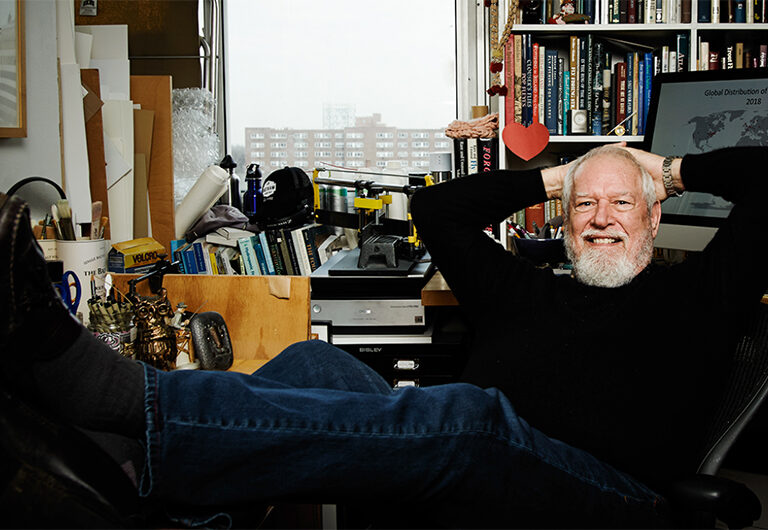Can you give some examples from the book of how urban design can successfully embrace biomimicry?
The principles described in my book are straightforward and rather simple. Look to nature for answers that could be applied to solving rapid climate change. In doing so, we might also be able to revitalize some of the ecosystems we have damaged. I begin The New City by describing some of the major issues that caused this disruption of natural systems, resulting in a rise in the average global temperature. In creating a new city, my Fordham class and I explored many viable options and settled on those that least harm the natural world. Four pillars serve as the premise for urban change.
The first change is to switch from steel and concrete for building materials to an engineered wood product—cross-laminated timber known as CLT—with characteristics similar to those found in mature trees. CLT has twice the strength of steel, is twice as light, and can be recycled and used for a new building. It is more fire-retardant than conventional construction materials, and, unlike any of those, it sequesters carbon, since it is made from wood. The trees CLT is made from will grow back in about 20 years, a renewable resource that will become available for manufacturing more CLT. Creating an abundance of trees to supply CLT manufacturers enables the restoration of damaged forests, particularly temperate-zone forests.
The second pillar is adding vertical farms to every building in the new urban environment. Cities occupy less than 3% of the world’s land mass, but generate over 60% of the greenhouse gases responsible for rapid climate change. Since 50% of the world population now lives in cities, urban environments must learn how to feed themselves (another function of trees), thereby helping to re-establish balanced ecosystems.
The third pillar—water harvesting. Water is essential for all life on earth. The anthropogenic world has had little interest in conserving fresh water until recently. Buildings should be designed to capture every drop of rainwater on their surface (just like trees do). Bermuda already does this. An example will show how more urban areas need to do so. New York City has a little over 300 square miles of physical footprint. Its average annual rainfall is about 47 inches. This might not seem like a lot of water to the casual observer, but a simple calculation suggests otherwise. The total amount of water that falls on New York annually is an astounding 240 billion gallons. This city consumes over 500 billion gallons a year to quench the thirst of its 8 million inhabitants. So New York could offset its freshwater demand by 20-30% if it were to retrofit its buildings to enable each one to capture rainwater. Moreover, the city discards some 1.2 billion gallons of wastewater daily. Remediating this water to become drinkable would alleviate future water shortages.
The final pillar: Converting cities from using fossil fuels to renewable energy resources, including solar, wind, and geothermal sources. On the near horizon, hydrogen fuel cell technologies will likely replace all energy-generating schemes. Why? Hydrogen fuel technologies do not generate harmful waste. The by-product of this approach’s energy production is water.
Are there cities that are employing these sustainable solutions?
Many cities are currently trying new approaches for all four pillars, and I reference them throughout the text.
Do you miss teaching?
Of course! Writing books is one way of continuing my passion for teaching. I love exposing students to new ideas, and then letting them run with those ideas. The outcomes are always surprising and rewarding. We who teach at times give students too little credit for self-motivation. Allowing them to take charge of an idea is empowering and life-changing, both for them and for us!
How do you remain active in your field?
I am a member of a podcasting crew headed by Vincent Racaniello, the Higgins Professor of Microbiology and Immunology at Columbia. I co-host two shows, This Week in Virology and This Week in Parasitism. I give several lectures yearly to various classes at the Mailman School of Public Health. I also co-founded Parasites Without Borders, and remain active with its projects. And I continue to do outreach and presentations to schools.
What books have you read lately that you would recommend, and why?
I must confess that writing a book consumes a lot of time, so my recreational reading has suffered a bit. My passion for trout fishing always leads me to fishing-related books. Anything written by Roderick Haig-Brown, a Canadian writer and conservationist who died in 1976, gets my attention. His writing goes far beyond the look-what-I-caught stage. I often pick up Fisherman’s Winter, one of his best books, and read from it. His observations of nature are exquisitely expressed, and he paints vivid mental images of the places he visited.
Of course, you cannot write a book about something as complex as rapid climate change without reading seminal works by experts. Here are some:
Hubbard Brook: The Story of a Forest Ecosystem by Richard Holmes and Gene Likens details how a mixed boreal forest in New Hampshire behaved after a catastrophic clearcut experience that Likens initiated in 1967. He and his colleagues then studied how the forest he tried to destroy recovered independently. Likens continues to study the Hubbard Brook Forest, using it as his laboratory. The project is the longest continuous ecological study in the world.
Finding the Mother Tree by Suzanne Simard delivers passionate prose about how nature works. The subtext is that almost no forestry scientists believed her results until a corps of young forest ecologists replicated them in their own forest patches. Using radioactive tracer metabolites, her influential discovery was that older trees “talk” to each other via chemical signaling pathways. This is how a city and its buildings should behave, and we have the technologies to make that happen.
The Overstory by Richard Powers is a novel with lots of science about forests and their survival, mixed into a riveting series of seemingly unrelated stories that all come together in the end.
What’s next on your reading list?
My next book.
Source link

